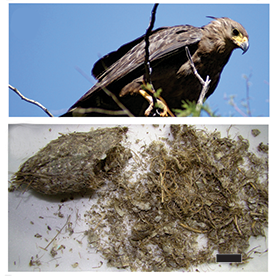WHO EATS THE ARMADILLOS? NEOTAPHONOMY OF ACCUMULATIONS PRODUCED BY THE CROWNED EAGLE (BUTEOGALLUS CORONATUS)
¿Quién se come a los armadillos? Neotafonomía de acumulaciones producidas por el Águila Coronada (Buteogallus coronatus)
DOI:
https://doi.org/10.5710/PEAPA.13.05.2025.529Keywords:
Actualistic taphonomy, Accipitridae, Chlamyphoridae, Digested osteoderms, Central–western ArgentinaAbstract
Neotaphonomic studies of vertebrates provide information about the mechanisms and processes that can modify the original characteristics of skeletal elements and can be used as analogues for interpretations on the origin of archeological and paleontological assemblages. The neotaphonomic evaluation of non-ingested bones (leftover prey remains) and modified digested bones by the crowned eagle (Buteogallus coronatus Accipitriformes, Accipitridae) is presented. Bones were recovered from the nests located in the central–west La Pampa Province, Argentina. Leftover prey remains include representatives of Aves, Iguania, Ophidia, Cingulata, Lagomorpha, and Carnivora. Bones from pellets correspond to Ophidia, Rodentia, and osteoderms of two armadillos Chlamyphoridae (Xenarthra, Cingulata). Some of the latter correspond to pichi (Zaedyus pichiy Euphractinae), a common species that is usually located in the diet of B. coronatus. Zaedyus pichiy osteoderms, recovered from pellets, present modifications in the original ornamentation, as well as a reduction in their thickness. Various pellets also contained remains of pink fairy armadillo (Chlamyphorus truncatus, Chlamyphorinae), a small paradigmatic, nocturnal and fossorial species, endemic to centralwestern Argentina, which is recorded for the first time as part of this raptor diet. This first mention of Chl. truncatus being captured by the crowned eagle is relevant because it involves two little–known and sympatric species, in an area where this armadillo is endemic. Osteoderms of Chl. truncatus show an extreme degree of modification, and it is interpreted that its potential of preservation in the fossil record is very low.
References
Abba, A. M., Tognelli, M. F., Seitz, V. P., Bender, J. B., & Vizcaino, S. F. (2012). Distribution of extant xenarthrans (Mammalia: Xenarthra) in Argentina using species distribution models. Mammalia, 76, 123–136. https://doi.org/10.1515/mammalia-2011-0089
Andrews, P. (1990). Owls, Caves and Fossils. Predation, Preservation, and Accumulation of Small Mammal Bones in Caves, with the Analysis of the Pleistocene Cave Faunas from Westbury-sub-mendip, Somerset. UK. Natural History Museum Publications, London, pp 231.
Badgley, C. (1986). Counting individuals in mammalian fossil assemblages from fluvial environments. Palaios. 1(3), 328–338. https://doi.org/10.2307/3514695.
Ballejo, F., Fernández, F. J. & De Santis, L. J. M. (2012). Tafonomía de restos óseos provenientes de egagrópilas de Coragyps atratus (Jote cabeza negra) en el noroeste de la Patagonia Argentina. Revista del Museo de Antropología 5, 213–222.
Ballejo, F., Hadler, P., Cherem, J. J., Bueno, L., Machado, J. S., Matarrese, A. B. & Fernández, F. J. (2022). The first fossil record of a bone assemblage accumulated by New World vultures (Gruta do Presepio, Holocene, southern Brazil). Boreas. https://doi.org/10.1111/bor.12579. ISSN 0300-9483
Barasoain, D., Basso, A. P., Sidorkewicj, N. S., Zurita, A. E., Montalvo, C. I., Casanave, E. B. & Tomassini, R. L. (2021). ¿Son los pichiciegos (Xenarthra, Cingulata, Chlamyphoridae) la figurita difícil? Análisis morfológico de ejemplares fósiles y actuales: relación con sus hábitos de vida. Publicación Electrónica de la Asociación Paleontológica Argentina 21 (R2), R6. https://www.peapaleontologica.org.ar/index.php/peapa/issue/394
Barasoain, D., Tomassini, R. L., Zurita, A. E., Montalvo, C. I. & Superina, M. A. (2020). A new fairy armadillo (Cingulata, Chlamyphoridae) from the late Miocene of Argentina: first fossil record of the most enigmatic Xenarthra. Journal of Vertebrate Paleontology 39, e1716778. https://doi.org/10.1080/02724634.2020.1716778
Borghi, C. E., Campos, C. M., Giannoni, S. M., Campos, V. E. & Sillero, C. (2011). Updated distribution of the pink fairy armadillo Chlamyphorus truncatus (Xenarthra, Dasypodidae), the world’s smallest armadillo. Edentata 12,14–19.
Cabrera, A. L. (1994). Regiones Fitogeográficas Argentinas. Enciclopedia Argentina de Agricultura y Jardinería. Tomo II. (pp 85). Ed ACME. Buenos Aires.
Casagrande, G. & Conti, H. A. (2004). Clima. In: Inventario Integrado de los Recursos Naturales de la Provincia de La Pampa. Ed. INTA/GLP/UNLPam. Buenos Aires.
Chebez, J. C., Maceda, J. J. & Pereyra-Lobos, R. (2008). Águila coronada. In: Chebez, J. C. (ed). Los que se van. Fauna Argentina amenazada (pp 177–186). Editorial Albatros, Buenos Aires.
Delsuc, F., Gibb, G. C., Kuch, M., Billet, G., Hautier, L., Southon, J., Rouillard J. M., Fernicola, J. C., Vizcaíno, S. F., MacPhee, R. D. E. & Poinar, H. N. (2016). The phylogenetic affinities of the extinct glyptodonts. Current Biology 26, 155–156. https://doi.org/10.1016/j.cub.2016.01.039
Delsuc, F., Superina, M., Tilak, M., Douzery, E. J. P. & Hassanin, A. (2012). Molecular phylogenetics unveils the ancient evolutionary origins of the enigmatic fairy armadillos. Molecular Phylogenetic and Evolution 62, 673–680. https://doi.org/10.1016/j.ympev.2011.11.008
Fernández, F. J., Montalvo, C. I., Fernández–Jalvo, Y., Andrews, P. & López, J. M. (2017). A reevaluation of the taphonomic methodology for the study of small mammal fossil assemblages of South America. Quaternary Science Reviews155, 37–49. https://doi.org/10.1016/ j.quascirev.2016.11.005
Fernández, F. J., Montalvo, C. I., Kin, M. S., Santillán, M., Procopio, D. E. & Travaini, A. (2024). Diet and multi-taxa neo-taphonomy of Glaucidium nana (Aves, Strigiformes) from southeastern Patagonia and comparisons with G. brasilianum from Chaco forest and other owls. Historical Biology. https://doi.org/10.1080/08912963.2024.2365369
Fernández–Jalvo, Y. & Andrews, P. (1992). Small mammal taphonomy of gran Dolina, Atapuerca (Burgos), Spain. Journal of Archaeological Science 19, 407–428. https://doi.org/10.1016/0305-4403(92)90058-B
Fernández–Jalvo, Y. & Andrews, P. (2016). Atlas of Taphonomic Identifications: 1001+ Images of Fossil and Recent Mammal Bone Modification. Springer: Berlin/Heidelberg, Germany, (pp 355).
Galmes, M. A. (2017). Ecología y Conservación del Águila Coronada (Buteogallus coronatus) en el Centro de Argentina. [Tesis Doctoral, Universidad Nacional del Comahue. Río Negro, Argentina.]
Galmes, M. A., Sarasola, J. H., Grande, J. M. & Vargas, H. (2018). Parental care in the endangered Chaco Eagle (Buteogallus coronatus) in Central Argentina. Journal of Raptor Research, 52 (3), 316–325. https://doi.org/10.3356/JRR-16-82.1
Gaudin, T. J. & McDonald, H. G. (2008). Morphology-based investigations of the phylogenetic relationships among extant and fossil xenarthrans. En: S. F. Vizcaíno and W. J. Loughry (eds.) The Biology of the Xenarthra. University Press of Florida, Gainesville, 24–36.
Gibb, G. C., Condamine, F. L., Kuch, M., Enk, J., Moraes–Barros, M., Superina, M., Poinar, H. N. & Delsuc, F. (2016). Shotgun mitogenomics provides a reference phylogenetic framework and timescale for living xenarthrans. Molecular Biology and Evolution 33, 621–42.
Guardia, N, M., Mignino, J., Zarco, A., Chiavazza, H., Maccio, C. & López, J. M. 2024. Non-ingested vertebrate prey remains accumulated by the Chaco eagle (Buteogallus coronatus): neo-taphonomy to evaluate open-air faunal records in central western Argentina. Journal of Archaeological Science: Reports 54, 04437 https://doi.org/10.1016/j.jasrep.2024.104437
Krmpotic, C. M., Scarano, A. C., Andrés Laube, P. F., Ciancio, M. R., Loza, C. M., Acuña, F., Castro, N. N. & Barbeit, C. G. (2024). The double skin of the pink fairy armadillo, the peculiar integumentary system of Chlamyphorus truncatus Cingulata (Mammalia, Xenarthra). Journal of Zoology. https://doi.org/10.1111/jzo.13136
Laudet, F., Denys, C. & Senegas, F. (2002). Owls, multirejection and completeness of prey remains: implications for small mammal taphonomy. Acta zoologica cracoviensia, 45(special issue), 341–355.
López, J. M., Otaola, C., Giardina, M., Huczac, C., Cona, M., Albanese, S., Cuevas, M. F., Campos, C. M. (2023). Neo-taphonomy of prey bone ingested by puma in central western Argentina. Journal of Archaeological Science: Reports, 47, 103733. https://doi.org/10.1016/j.jasrep.2022.103733
Lyman, R. L. (1994). Vertebrate taphonomy. Cambridge: Cambridge University Press.
Lyman, R. L. (2018). Actualistic neotaphonomic research on bone modifying animal species: an analysis of the literature. Palaios 33, 542–554. https://dx.doi.org/10.2110/palo.2018.042
Maceda, J. J. (2007). Biología y conservación del Águila Coronada (Harpyhaliaetus coronatus) en Argentina. Hornero 22, 159–171.
Maceda, J. J., Sarasola, J. H. & Pessino, M. E. M. (2003). Presas consumidas por el Águila Coronada (Harpyhaliaetus coronatus) en el límite sur de su rango de distribución en Argentina. Ornitología Neotropical 14, 419–422.
Minoprio, J. L. (1945). Sobre el Chlamyphorus truncatus Harlan. Acta Zoológica Lilloana, 3, 5-58.
Montalvo, C. I., Bisceglia, S., Kin, M. & Sosa, R. A. (2012). Taphonomic analysis of rodent bone accumulations produced by Geoffroy’s cat (Leopardus geoffroyi, Carnivora, Felidae) in Central Argentina. Journal of Archaeological Science, 39, 1933–1941. https://doi.org/10.1016/j.jas.2012.02.024
Montalvo, C. I. & Fernández, F. J. (2019). Review of the actualistic taphonomy of small mammals ingested by South American predators. Its importance in the interpretation of the fossil record. Publicación Electrónica de la Asociación Paleontológica Argentina 19 (1), 18–46. http://dx.doi.org/10.5710/PEAPA.11.03.2019.275
Montalvo, C. I., Fernández, F. J., Bargo, M. S., Tomassini, R. L. & Mehl, A. (2017). First record of a Late Holocene fauna associated with an ephemeral fluvial sequence in La Pampa Province, Argentina. Taphonomy and paleoenvironment. Journal of South America Earth Science. 76, 225–237. https://dx.doi.org/10.1016/j.jsames.2017.03.007
Montalvo, C. I., Fernández, F. J., Galmes, M., Santillán, M. & Cereghetti, J. (2016a). Crowned solitary eagle (Buteogallus coronatus) as accumulator of armadillos osteoderms in the archaeological record? An actualistic taphonomy study for Central Argentina. Quaternary International 391, 90–99. https://doi.org/10.1016/j.quaint.2015.08.017
Montalvo, C. I., Fernández, F. J., Liébana, M. S., Santillán, M. & Sarasola, J. H. (2014). Taphonomic analysis of rodent bone accumulations produced by the White-tailed Kite (Elanus leucurus, Accipitriformes) in Central Argentina. Journal of Archaeological Science 52, 354–362. https://doi.org/10.1016/j.jas.2014.09.003
Montalvo, C. I., Fernández, F. J., Tomassini, R. L., Mignino, J., Kin, M. S. & Santillán, M. A. (2020). Spatial and temporal taphonomic study of bone accumulation of the burrowing owl (Athene cunicularia) in central Argentina. Journal of Archaeological Science: Reports 30 (102197) https://doi.org/10.1016/j.jasrep.2020.102197
Montalvo, C. I., Pessino, M. E. & Bagatto, F. C. (2008). Taphonomy of the bones of rodents consumed by Andean hog-nosed skunks (Conepatus chinga, Carnivora, Mephitidae) in central Argentina. Journal of Archaeological Science 35, 1481–1488. . https://doi.org/10.1016/j.jas.2007.10.011
Montalvo, C. I., Pessino, M. & González, V. (2007). Taphonomic analysis of remains of mammals eaten by pumas (Puma concolor Carnivora, Felidae) in central Argentina. Journal of Archaeological Science 34, 2151–2160. https://doi.org/10.1016/j.jas.2007.02.012
Montalvo, C. I. & Tallade, P. O. (2009). Taphonomy of the Accumulations Produced by Caracara plancus (Falconidae). Analysis of Prey Remains and Pellets. Journal of Taphonomy 7, 235–248.
Montalvo, C. I., Tallade, P. O., Fernández, F. J., Moreira, G., Rafuse, D. & De Santis, L. J. M. 2011. Bone damage patterns found in the avian prey remains of crested caracara Caracara plancus (Aves, Falconiformes). Journal of Archaeological Science 38, 3541–3548. https://doi:10.1016/j.jas.2011.08.021
Montalvo, C. I., Tomassini, R. L., Cerdeño, E. & Fernández, F. J. (2023). A late Miocene mammal assemblage reveals a complex taphonomic history in fluvial deposits of Central Argentina. Historical Biology, 35, 645–660. https://doi.org/10.1080/08912963.2022.2060100
Montalvo, C. I., Tomassini, R. L. & Sostillo, R. (2016b). Leftover prey remains: a new taphonomic mode from the late Miocene (Cerro Azul Formation) in central Argentina. Lethaia 49, 219–230. https://doi.org/10.1111/let.12140.
Oyarzabal, M., Clavijo, J. Oakley, L., Biganzoli, F., Tognetti, P., Barberis, I., Maturo, H. M., Aragón, R., Campanello, P., Prado, D., Oesterheld, M. & León, R. J. C. (2018). Unidades de vegetación de la Argentina. Ecología Austral 8, 040–063. http://hdl.handle.net/20.500.12110/ecologiaaustral_v028_n01_p040
Parera, A. F. (2018). Los mamíferos de la Argentina y la región austral de Sudamérica. (pp. 464). Segunda Edición, AP Ediciones Naturales.
Pereyra–Lobos, R., Santander, F. J., Alvarado Orellana, S., Ramírez, P. A., Muñoz, L. & Bellón, D.F. (2011). Diet of the Crowned Eagle (Harpyhaliaetus coronatus) During the Breeding Season in the Monte Desert, Mendoza, Argentina. Journal of Raptor Research. 45, 180–183. https:// doi.org/10.3356/JRR-10-36
Raczynsji J. & Ruprecht, A. L. (1974). The effect of digestion on the osteological composition of owl pellets. Acta Ornithology 14, 25–38.
Redford, K. H. & Eisenberg, J. F. (1992). Mammals of the Neotropics. The Southern Cone. Chile, Argentina, Uruguay, Paraguay. (pp. 440). University of Chicago Press, Illinois, USA.
Ringuelet, R. A. (1961). Rasgos fundamentales de la zoogeografía de la Argentina. Physis, Buenos Aires, 22, 151–170.
Sarasola, J. H., Gallego, D. & Martínez-Miranzo, B. (2022). Chaco Eagle Ecology and Conservation. In: D. A. DellaSala, M. I. Goldstein, (Eds.), Imperiled: The Encyclopedia of Conservation, (1). Elsevier, (pp. 102–112). https://dx.doi.org/10.1016/B978-0-12-821139-7.00025-8
Sarasola, J., Santillán, M. & Galmes, M. (2010). Crowned Eagles rarely prey on livestock in central Argentina: persecution is not justified. Endangered Species Research, 11, 207–213.
Scillato–Yané, G. J. (1982). Los Dasypodidae (Mammalia: Edentata) del Plioceno y Pleistoceno de Argentina. [Ph.D. dissertation, Facultad de Ciencias Naturales y Museo, Universidad Nacional de La Plata, La Plata, Argentina].
Scillato–Yané, G. J., Gois, F., Zurita, A. E., Carlini, A. A., González Ruiz, L. R., Krmpotic, C. M., Oliva, C. & Zamorano, M. 2013. Los Cingulata (Mammalia, Xenarthra) del “Conglomerado osífero” (Mioceno tardío) de la Formación Ituzaingó de Entre Ríos, Argentina. In: D. Brandoni, J.I. Noriega, (Eds). El Neógeno de la Mesopotamia Argentina. Asociación Paleontológica Argentina, Publicación Especial 14: 118–134.
Siegenthaler, G. B. (2004). Relevamiento de los vertebrados de la Provincia de La Pampa. In: Inventario integrado de los recursos Naturales de la Provincia de La Pampa. Clima, Geomorfología, Suelo, Vegetación y Fauna de Vertebrados. Reedición. INTA, UNLPam, Gobierno de La Pampa, Santa Rosa, Argentina. https://recursosnaturales.lapampa.edu.ar/rel_fr.html
Soibelzon, E., Miño-Boilini, A. R., Zurita, A. E. & Krmpotic, C. M. (2010). Los Xenarthra (Mammalia) del Ensenadense (Pleistoceno inferior a medio) de la Región Pampeana (Argentina). Revista Mexicana de Ciencias Geológicas, 27: 449-469.
Soibelzon, E., Negrete, J., Ciai, D. & Martin, G. M. (2021). Riqueza de mamíferos no voladores de la provincia de La Pampa (Argentina) a través de diversas técnicas de muestreo. Mastozoología Neotropical, 28, (1): e0543. https://doi.org/10.31687/saremMN.21.28.1.0.25
Superina, M. (2000). Biologie und Haltung von Gürteltieren (Dasypodidae). [Doctoral thesis. Institut für Zoo-, Heim- und Wildtiere, Universität Zürich, Zürich]. Recuperado el 27/1/2025; https://xenarthrans.org/wp-content/uploads/2019/10/Superina_Biologie-und-Haltung-von-Guerteltieren.pdf
Superina, M. (2006). New information on population declines in pink fairy armadillos. Edentata 7, 48–50.
Superina, M. (2008). The ecology of the pichi Zaedyus pichyi in western Argentina. In:. S. F. Vizcaíno, W. J. Loughry, (Eds.). The biology of the Xenarthra. (pp. 313–318). University Press of Florida, Gainesville.
Superina, M. (2011). Husbandry of a Pink Fairy Armadillo (Chlamyphorus truncatus): Case Study of a Cryptic and Little Known Species in Captivity. Zoo Biology 30, 225–231. https://doi.org/10.1002/zoo.20334
Superina, M. & Abba, A. M. (2014). Zaedyus pichiy. The IUCN Red List of Threatened Species: e.T23178A47443734. https://dx.doi.org/10.2305/IUCN.UK.2014-1.RLTS.T23178A47443734.en
Superina, M. & Loughry, W. J. (2012). Life on the Half-Shell: Consequences of a Carapace in the Evolution of Armadillos (Xenarthra: Cingulata). Journal of Mammalian Evolution 19, 217–224. https://doi.org/10.1007/s10914-011-9166-x
Superina, M., Pagnutti, N. & Abba, A. M. (2014). What do we know about armadillos? An analysis of four centuries of knowledge about a group of South American mammals, with emphasis on their conservation. Mammal Review 44, 69–80. https://doi.org/10.1111/mam.12010
Tambussi, C. P., Degrange, F. J. & De Mendoza, R. S. (2023). 'The present state of knowledge of the Cenozoic birds of Argentina' by Tonni 1980: four decades after. Publicación Electrónica de la Asociación Paleontológica Argentina 23(1): 255–295. DOI: https://doi.org/10.5710/PEAPA.13.08.2022.418
Tambussi, C. P., & Noriega, J. I. (1996). Summary of the Avian Fossil Record from Southern South America; pp. 245–264. In G. Arratia, (Ed.). Contributions of Southern South America to Vertebrate Paleontology. Muncher Geowissenschaftliche Abhandlungen, Munich.
Tomassini, R. L, Marín Monfort, M. D., García Morato, S., Montalvo, C. I., Barasoain, D., Zaracho, E. M., Chatellenaz, M. L., Garrone, M.C., Zurita, A. E. & Fernández–Jalvo, Y. (2023). Armadillo osteoderms altered by digestion and how taphonomy can help taxonomy. Palaios, 38, 31–42. http://dx.doi.org/10.2110/palo.2022.040
Tonni, E. P. (1980). The present state of knowledge of the Cenozoic birds of Argentina. Contributions in Science, Natural History Museum, Los Angeles 330:105–114.
Torres, R., Abba, A. M. & Superina, M. (2015). Climate fluctuations as a cause of rarity in fairy armadillos. Mammalian Biology 80, 452–458. https://doi.org/10.1016/j.mambio.2015.07.007
Verga, E. G., Hümoller, H. L. S., Vergara–Tabares, D. L., Galetto, L. & Peluc, S. I. (2019). Importancia para la conservación de las aves de un relicto de bosque en la región fitogeográfica del Espinal, Argentina. Neotropical Biology and Conservation 14 (2), 241–256. https://doi.org/10.3897/neotropical.14.e37920
Verzi, D. H., Montalvo, C. I. & Deschamps, C. M. (2008). Biostratigraphy and biochronology of the Late Miocene of central Argentina: Evidence from rodents and taphonomy. Geobios 41, 145–155.
Wetzel, R. M. (1985). The identification and distribution of recent Xenarthra (Edentata). En: Montgomery, G.G. (Ed.). The evolution and ecology of armadillos, sloths, and vermilinguas. (pp. 5–21). Smithsonian Institution Press, Washington.
Woodman, N., Dove, C. J. & Peurach, S. C. (2005). A Curious Pellet From a Great Horned Owl (Bubo virginianus). Northeastern Naturalist, 12, 127–132.

Additional Files
Published
Issue
Section
License
Copyright (c) 2025 Claudia Inés Montalvo, Marta Susana Kin, Fernando Julián Fernández, Maximiliano Adrián Galmes, Daniel Barasoain, Rodrigo Leandro Tomassini

This work is licensed under a Creative Commons Attribution-NoDerivatives 4.0 International License.
Authors retain copyright and grant the journal right of first publication with the work simultaneously licensed under a Atribución/Reconocimiento 4.0 Internacional that allows others to share the work with an acknowledgement of the work's authorship and initial publication in this journal.















